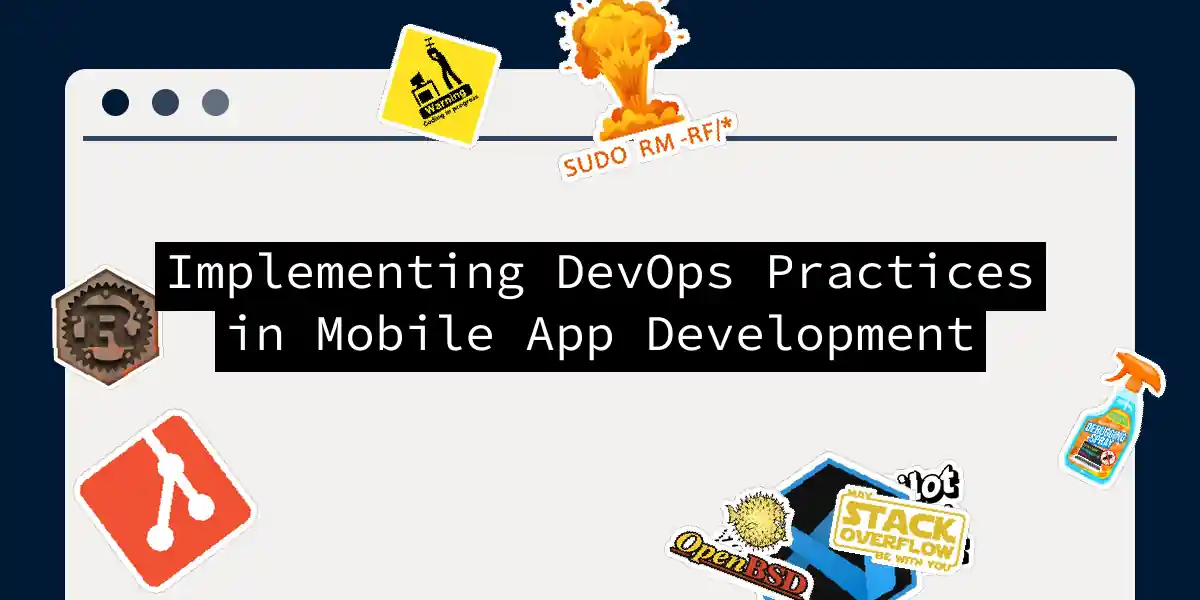The DevOps Revolution in Mobile App Development
In the fast-paced world of mobile app development, staying ahead of the curve is not just a suggestion, it’s a necessity. One of the most effective ways to achieve this is by embracing DevOps practices. DevOps is more than just a buzzword; it’s a cultural and technological shift that can transform how you develop, deploy, and maintain your mobile applications.
Why DevOps?
Before we dive into the nitty-gritty, let’s address the elephant in the room: why do you need DevOps in the first place? The answer is simple: efficiency, quality, and reliability. Traditional development methods often lead to siloed teams, manual processes, and a plethora of errors that can delay your app’s release and frustrate your users. DevOps changes this by fostering collaboration, automation, and continuous improvement.
Key DevOps Practices for Mobile App Development
1. Source Control Management
Effective source control is the backbone of any successful DevOps strategy. Tools like Git or Bitbucket ensure your codebase is well-organized and easily manageable. Here’s a simple example of how you can use Git to manage your code:
# Initialize a Git repository
git init
# Add files to the staging area
git add .
# Commit changes
git commit -m "Initial commit"
# Push changes to a remote repository
git remote add origin https://github.com/your-repo.git
git push -u origin master
2. Continuous Integration and Continuous Deployment (CI/CD)
CI/CD pipelines are the heart of DevOps. They automate the build, test, and deployment processes, ensuring that code changes are integrated and tested regularly. Here’s a high-level overview of a CI/CD pipeline using Jenkins:
3. Automated Testing
Automated testing is crucial for maintaining the quality and performance of your mobile app. By integrating various types of automated tests into your CI/CD pipeline, you can catch bugs early and ensure that new code doesn’t break existing functionalities.
Here’s an example of how you might set up automated testing using Selenium for a mobile app:
import org.openqa.selenium.By;
import org.openqa.selenium.WebDriver;
import org.openqa.selenium.WebElement;
import org.openqa.selenium.remote.DesiredCapabilities;
import org.openqa.selenium.remote.RemoteWebDriver;
public class MobileAppTest {
public static void main(String[] args) throws Exception {
DesiredCapabilities capabilities = new DesiredCapabilities();
capabilities.setCapability("browserName", "chrome");
capabilities.setCapability("deviceName", "Pixel 4");
capabilities.setCapability("platformName", "Android");
capabilities.setCapability("app", "/path/to/your/app.apk");
WebDriver driver = new RemoteWebDriver(new URL("http://localhost:4723/wd/hub"), capabilities);
// Perform some actions on the app
WebElement element = driver.findElement(By.id("your_element_id"));
element.click();
// Assert the expected behavior
Assert.assertTrue(driver.findElement(By.id("expected_element_id")).isDisplayed());
driver.quit();
}
}
4. Infrastructure as Code (IaC)
Managing your infrastructure through code ensures consistent and repeatable deployments. Tools like Terraform or AWS CloudFormation allow you to define your infrastructure using configuration files.
Here’s an example of how you might define a simple infrastructure using Terraform:
provider "aws" {
region = "us-west-2"
}
resource "aws_instance" "example" {
ami = "ami-0c94855ba95c71c99"
instance_type = "t2.micro"
}
5. Monitoring and Logging
Continuous monitoring and logging are essential for maintaining the health and performance of your mobile app. By tracking key metrics and logging important events, you can easily identify and resolve issues.
Here’s an example of how you might set up logging using Logcat for an Android app:
import android.util.Log;
public class YourActivity extends AppCompatActivity {
private static final String TAG = "YourActivity";
@Override
protected void onCreate(Bundle savedInstanceState) {
super.onCreate(savedInstanceState);
// Log an event
Log.d(TAG, "Activity created");
}
}
6. Release Management
Successful release management ensures that new features and bug fixes are delivered to users smoothly and efficiently. This involves planning, testing, and deploying releases in a controlled manner.
Here’s a sequence diagram illustrating the release management process:
Implementing DevOps: A Step-by-Step Guide
Step 1: Continuous Integration and Delivery
Ensure that developers write code in a manner that can be easily integrated with others. Use tools like Jenkins or GitLab CI/CD to automate the integration process.
Step 2: Testing and Monitoring
Implement automated testing to catch bugs early. Use tools like Selenium for functional testing and JUnit for unit testing. Also, set up monitoring tools like Nagios or Prometheus to track key metrics.
Step 3: Infrastructure as Code
Use IaC tools to define and manage your infrastructure. This ensures that your environments remain consistent and reduces the risk of configuration drift.
Security in DevOps
Security is not an afterthought in DevOps; it’s integrated into every stage of the development lifecycle. This approach, known as DevSecOps, ensures that security measures are automated and continuous.
Here’s how you can incorporate security into your CI/CD pipeline:
Conclusion
Implementing DevOps practices in mobile app development is not a one-time task; it’s a continuous journey. By adopting these practices, you can significantly improve the efficiency, quality, and reliability of your applications. Remember, DevOps is not just about tools and processes; it’s about fostering a culture of collaboration, automation, and continuous improvement.
So, the next time you’re about to embark on a new mobile app project, don’t just think about writing code; think about how you can integrate DevOps into every step of your development process. Your users (and your sanity) will thank you.
